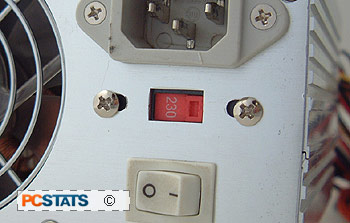This can also happen with brand new components, as anyone who works in a computer
store knows.
"My friend's system had died due to a blown PSU, so
I told him to put his RAM in another system for testing. Moving the RAM to a
second system resulted in... you guessed it, a second dead PC. I figured he had
just been careless and duly chastised him. Deciding this type of work was best
left to the pros, I took the RAM home with me to test on my system. And you
guessed right, a third dead PC..."
Also, as computer technology progresses, incompatibilities with older parts
are introduced, meaning in some cases parts that fit perfectly well in your
system may go up in smoke as soon as you turn the power on.
How Not to Kill Your Computer This
Way
Be diligent. It's hard to protect your system against defective new
components, but if you are adding something old or second hand, make darn sure
that you know it works and is compatible with your computer's technology before
plugging it in (or at least make sure you have a fire extinguisher handy).
If one of your systems suffered a power supply failure or other major damage
and you need to test which parts survived, don't do the testing with a brand new
system. If you or your friends don't have an expendable system to test
with, take the wreck into a computer store and have them test it. It
should be worth the price to avoid the risk of having a damaged RAM chip or
video card toast your next system too.
Power On, Brain Off
It's a little disappointing to see this particular category so high up on the
list, but then all of us have had our share of brain-dead computer incidents,
things that you just know you shouldn't do, things like plugging and unplugging
cables inside your case with the computer on.
"I was frustrated one day because every
configuration I had set up would not read my second slaved hard drive. All the
jumpers were set right, cable was perfectly fine, and still no second hard disk.
So with the computer on, I finally noticed with my last try that the power cable
was not in the second drive. I then decided to plug the power connector into the
second hard drive with the computer still on. I'm sure you can figure out the
end result."
Just
for the record, nothing inside your system should be touched while the power is
on. I don't care if Joe at your local AlphaBetaGamma computer store told
you that floppy drives were hot swappable, just don't do it!
"Once, in my early days of Hardware work, I decided
to swap in a hard drive while the computer was running (It was taking a long
time to shut down). Unfortunately, the Molex connector on the Hard Drive was
upside down, and when I attempted to connect it, I put the connector in off
centre, creating sparks.  I then dropped
the Hard drive (steel side down) onto my new graphics card. Sparks went
everywhere, and I lost a hard drive and a video card..."
I then dropped
the Hard drive (steel side down) onto my new graphics card. Sparks went
everywhere, and I lost a hard drive and a video card..."
Another common source of amusingly pyrotechnic computer disasters is that
little self-destruct switch that most power supplies possess; that's right, the
red switch that changes between 115 and 230 volts. Changing this to the
wrong setting can cause a power supply failure as in the first part of this
article in a matter of seconds. You really should know better.
"My friend was having booting problems. Figuring it
had something to do with his hardware, he turned the system around. Seeing a
switch, he figured it might fix his problem, so he decides to flick it... 120v
to 240volts... a huge white light illuminated inside his case and then his
computer gurgled to a halt."
How Not to Kill Your Computer This
Way
Don't be an idiot. You have a power button; use it.

